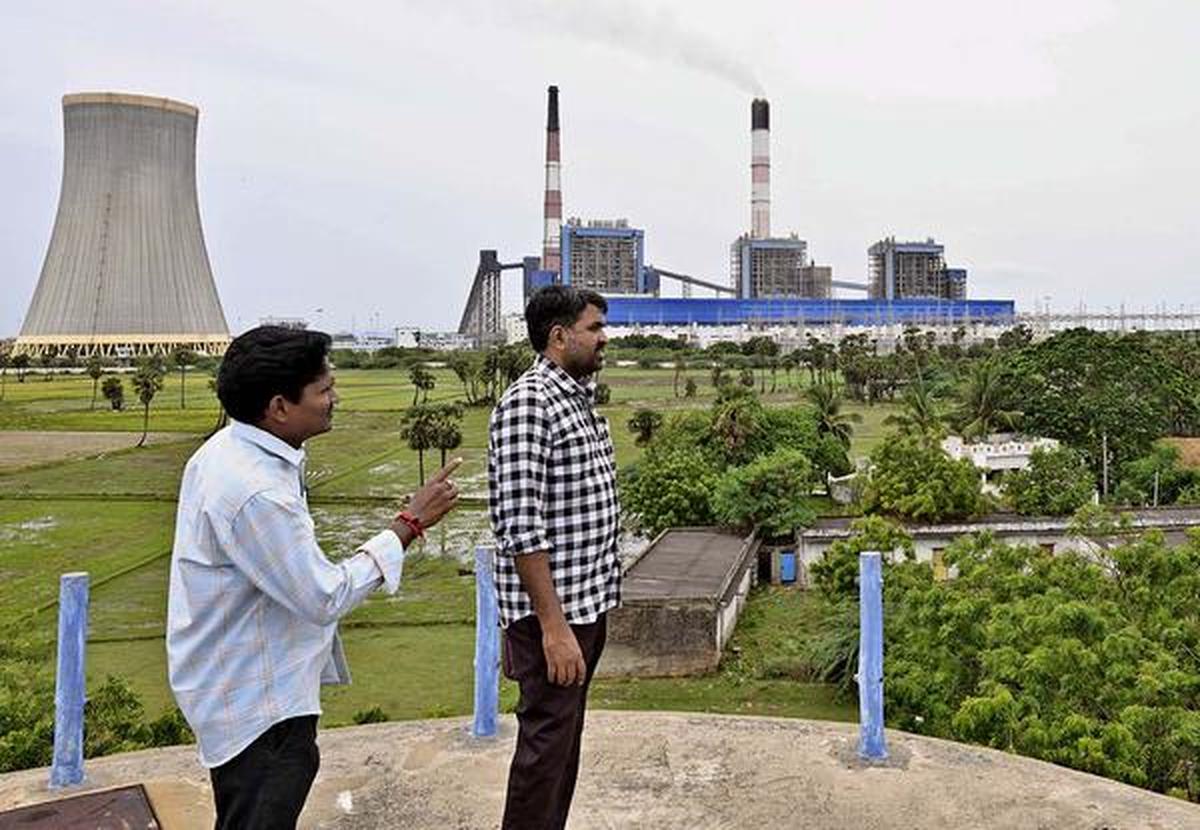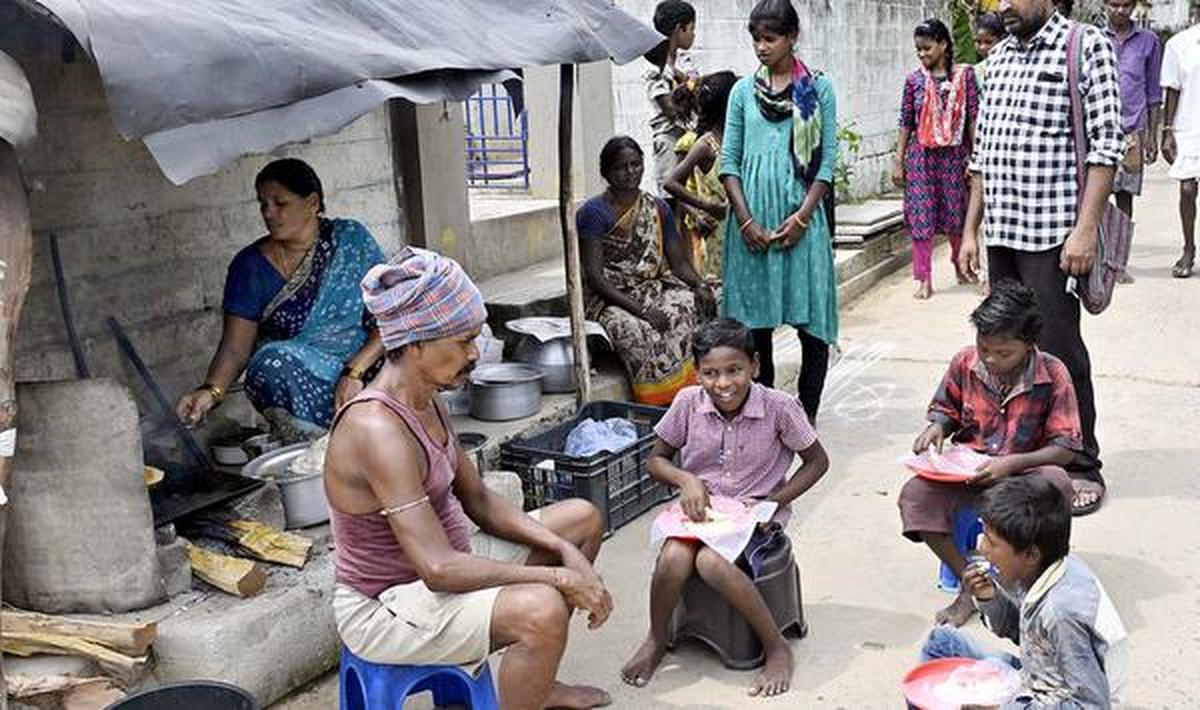The hot oil begins to sizzle as Sarojamma, 42, a daily wage earner, lights her stove in the courtyard of her hut to make bajjis (fritters) for her two children aged 12 and 14. She squints, checking the frying pan for any specks of ash, and deftly flicks one away with her finger.
Sarojamma lives in Pynampuram, a predominantly tribal habitation located close to the Sri Damodaram Sanjeevaiah Thermal Power Station, established by Andhra Pradesh Power Generation Corporation Ltd with an initial capacity of 800 MW in March 2014, in Nelaturu village of A.P.’s Sri Potti Sriramulu (SPSR) Nellore district.
The village has a population of nearly 2,500.
The second 800-MW unit was added in February 2016 and the third 800-MW unit in October 2022.
Smoke constantly billows from the thermal plant’s cooling tower, spreading thin flakes of soot and ash over the nearby villages. Students at the nearby Anganwadi school have their lunch on the verandah outside, exposing their food to fly ash. Locals throng roadside eateries notwithstanding concerns over health risks.
While the soot and ash give sleepless nights to residents of this belt, villages south and southeast of Nelaturu in Muthukuru mandal face the hazard of fine particulate matter from iron ore and coal dumped at Krishnapatnam, India’s second-largest private port.
“We have been facing this problem of pollution for nearly 10 years and have represented to the district collector several times, but to no avail,” says B. Kanakaiah, sarpanch of Nelaturu panchayat.
The A.P. government had planned to relocate the village and rehabilitate residents near Madaraju Guduru, about 15 kilometres away. Some houses were partially built for the residents, but progress on Harijanawada (Dalit colony) and Palem (fishermen hamlet) has stalled due to alleged financial crunch.
When the thermal power stations and Krishnapatnam port were proposed by the government over two decades ago, the coastal region of Nellore was viewed as a potential paradise. National media turned its attention to the perennially-backward region, corporate giants explored its business potential, and real estate boomed around Nellore city, 30 kilometres away. However, while the villagers anticipated prosperity, it is only soot, ash and dust that has filled the air, along with widespread despair.
Twenty years on, life in the predominantly rural coastal belt has deteriorated. The vast coast, serene backwaters, lush green fields and barren lands have turned brown due to soot from thermal plants, ash from treatment facilities, and iron ore and coke handled by the all-weather, deep water port.
The residents of Muthukur, Venkatachalam (in Sarvepalli constituency), Chillakur, and Thotapalli Gudur mandals (Gudur constituency) are the victims of this pollution and prolonged neglect. “There has been a surge in the number of patients complaining of breathing difficulties, throat irritation, skin rashes, and worsening bronchial asthma, leading to increased hospital admissions. These symptoms appear to be the consequences of air pollution,” says Alladi Mohan, professor of Medicine and dean at Sri Venkateswara Institute of Medical Sciences, Tirupati.
According to Dr. Mohan, many of these patients are from SPSR Nellore district, residing in the vicinity of thermal power plants. He observes that pollutants like sulfur dioxide, nitrogen oxides, hydrogen chloride, polycyclic aromatic hydrocarbons, and both coarse and fine particulate matter in the emissions are likely causing the health issues.
The government chose this belt for its proximity to the coast, apart from factoring in the absence of contiguous habitations and availability of vast tracts of barren lands.
While environmental degradation is expected in case of large-scale industrialisation, local employment is supposed to offset the negative impacts. However, the thermal power stations, the port, and Special Economic Zone (SEZ) for port-based industries have failed to generate jobs that had been promised during land acquisition. The few industrial units established are grossly insufficient for the thousands of acres acquired. The employment potential anticipated in the late ’90s has also fallen far short of expectations.

Realignment of port operations
The latest development is that the Adani Ports and Special Economic Zone Limited (APSEZ), which operates this port, has decided to shut down its container business in Krishnapatnam due to declining volumes.
For context, Navayuga Engineering Company Limited (NECL) completed first phase construction of the port in a record time of 18 months. It was inaugurated by senior Congress leader and former UPA chairperson Sonia Gandhi on July 17, 2008. The port featured state-of-the-art mechanical cargo handling equipment, capable of processing bulk cargo at the rate of 100,000 million tonnes (MT) per day, and handled 54.37 MT of cargo in the financial year 2019-20.
NECL faced difficulties after the A.P. government terminated its Polavaram project and Machilipatnam Port Project contracts. Besides, external factors led to a sharp decline in iron ore exports, forcing the company to rely solely on coal, palm oil and container business.
In 2021, Adani Ports and SEZ Limited acquired the entire stake from NECL, the promoter company, gaining full control over the port. Since Adani also owns the Kattupalli and Ennore ports near Chennai, the closest functional ports to Krishnapatnam, the company is learnt to have decided to reorganise their bulk cargo and container businesses to align with their business needs and the demand-supply mechanism.
As a result, the company reportedly started focusing more on bulk cargo like iron ore, coke, edible oil, and fly ash, creating a situation to shift the container business to the other two ports. Sources suggest the last container vessel reached Krishnapatnam port on January 26 this year.
Attempts to reach the port management for clarification were unsuccessful.

Livability vs livelihood debate
The port’s decision sparked a political slugfest between the YSR Congress Party (YSRCP) and the Telugu Desam Party (TDP), the current ruling party, over the past couple of years, with heated debates centering on both livability and livelihood issues.
Krishnapatnam falls under Sarvepalli constituency. During 2019-2024, it was represented by YSRCP’s Kakani Govardhan Reddy, and now, after the 2024 general elections, by TDP’s Somireddy Chandramohan Reddy.
Interestingly, both have served as agriculture minister in the past, offering insights on the region’s soil, crops, water bodies and the local community.
Before the 2024 elections, Chandramohan Reddy had criticised the port management for ignoring the locals’ interests, as also the YSRCP regime for not taking a stand.
On the other hand, Govardhan Reddy had defended the government led by his party, insisting that the port was not shifting its container business as alleged.
After the change of guard in the State, Chandramohan Reddy, as the representative of the ruling TDP, has softened his stand and renewed his appeal to the Adani Ports and SEZ management to reconsider its decision to shift the container business to other ports.
“This decision will leave Krishnapatnam with fly ash, iron ore and coal, collectively referred to as dirty cargo. We don’t want Krishnapatnam to become a dumping yard. I once again appeal to the port management to consider the plight of the farmers who gave away their precious lands for the development of the region,” says Chandramohan Reddy.
For his part, Govardhan Reddy attributes the lack of port-based industries around Krishnapatnam port and SEZ as the major reason that the import/ export business has not met projected expectations.
“The port management may have valid reasons for choosing the nature of business and switching the product line between its array of ports, but it cannot ignore the impact on livelihoods that will be affected by shunning specific operations at our port,” he points out.
With not many industrial units coming up, the families of farmers who gave away their lands have seen their hopes dashing to the ground. The handling of bulk cargo is fully mechanised — iron ore is transported by railway wagons and edible oil by pipelines — resulting in minimal job creation. In contrast, container traffic supports a wide range of activities, involving importers, exporters, transporters, business agents, freight handlers, cold storage, and processing units, making the region a hub of activity.
“Already, there aren’t as many industries around the port on the scale as initially envisioned. If the container business also moves out, the processing units, freight agents, and even fuel stations set up around the port will have to wind up operations, turning Krishnapatnam into a ghost town. The government should intervene in this matter,” insists Gogula Srinivasulu, general secretary of the Centre of Indian Trade Unions for the Krishnapatnam Industrial Cluster.
Another silent casualty is the local fisherfolk community living near the Krishnapatnam coast. Due to pollution from the thermal plant and dredging activities for the port, fishermen, who used to venture 3-4 kilometres into the sea before the port became a reality, now have to go up to as far as 15 kilometres. Despite travelling further, their catch remains the same, leading to higher fuel costs and burning a hole in their pockets. In other words, fishing has become unviable.
Similarly, the sea salt harvesting units, spread across roughly 700 acres near the coast, faced a rude shock when rising pollution brought the industry to a grinding halt. “Around 3,000 people dependent on the salt-making industry lost their livelihoods,” laments Srinivasulu.
Amid this bleak landscape, the once-promised paradise remains a distant dream. “Our struggle against pollution and neglect is far from over, but we are holding on to the hope that one day, prosperity will knock on our doors,” says a 38-year-old resident of Nelaturu, refusing to be named.





